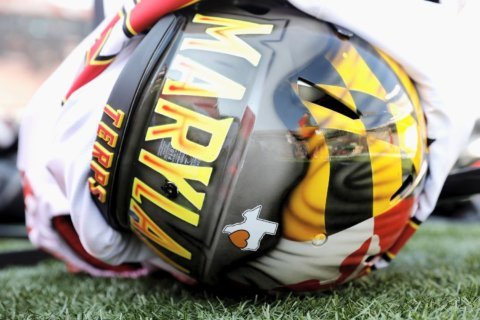WASHINGTON — What an incredible disaster.
One day after announcing that it was keeping DJ Durkin as head football coach, the University of Maryland — awash in a tidal wave of justified outrage — reversed course and parted ways with him. I’m not using that news release term — “parted ways” — to make anything sound more dignified. I’m using it because they didn’t really fire him. They bought him out, the same way they bought out strength coach Rick Court.
Yes, the University of Maryland used taxpayer dollars to settle financially with the men in charge of Jordan McNair, the 19-year-old who died in June, rather than fire them for cause. Why? Because none of this fiasco really has anything to do with accountability or the safety and well-being of the football players, only the careers of those in charge of them and the image of the school itself.
To understand the world in which these decisions were made, you have to first understand that there is football, and then there is FOOTBALL. Football is the dangerous sport that athletes sign up to play, for a college scholarship, a chance to go pro, simple love of the game, or any combination of the above. FOOTBALL is the apparatus that takes advantage of all of that, where universities can spend millions on coaches and hundreds of millions on flashy new facilities, but the players are unpaid, their scholarships not guaranteed, serving as disposable labor for the benefit of others.
FOOTBALL is why players were shown videos of “serial killers, drills entering eyeballs, bloody scenes with animals eating animals, (and) rams and bucks running at each other at full speed” during breakfast, as the Commissioners’ Report found.
Let’s be perfectly clear: Football didn’t kill Jordan McNair. But FOOTBALL did. FOOTBALL insisted he run on a hot day until he collapse, that he be mocked for his weakness and dragged around by his trainers instead of given the medical aid that would have saved his life.
College football, as it’s intentionally constructed, is a system of children and adults. The players are legal adults — McNair was 19 — but for any practical purpose to the university, they are kids. They aren’t paid. They have no agency to collectively bargain. They don’t have the basic rights to make money from their talents that their fellow, nonathletic students do. Their playing time rests at the whims of their coaches, who can take it away for any reason they see fit. Their only recourse is to transfer, if another school will take them, usually losing a year of eligibility and placing themselves in another system where they are just another kid under the thumb of another omnipotent coach.
It’s what the system insists.
When the three players who reportedly walked out of Durkin’s meeting with the team Tuesday did so, they knew what that meant. They would almost certainly never play another down of football unless they, or Durkin, left the University of Maryland. If Durkin stayed, maybe — if they were lucky, if their position coaches vouched for them anyway, if they ended up at a school unlike Maryland (or South Carolina, or Michigan) — they would get to play again. But they made the calculation that it wasn’t worth it to play for Durkin and took their chances the only way they could. They should never have had to make that call, but good for them.
FOOTBALL is why Maryland Athletic Director Damon Evans even has a job in the first place, why Maryland is even in the Big 10. It was Evans’ success with FOOTBALL (and its ever-more-ludicrous counterpart, BASKETBALL) at the University of Georgia that gave him a second chance. Ah, yes, in case you didn’t know the reasons Evans is no longer at Georgia, go ahead and read this.
Then, consider that just this summer, Evans had another scandal, from which he was officially cleared of any wrongdoing in June. Cleared, of course, by the same University we’ve seen bungle this current mess. Despite all of that, Evans was still at Maryland. Because FOOTBALL.
Now, consider the chain of events over the last 48 hours from Evans’ perspective. First, the coaching staff created a toxic-but-not-“toxic” culture, led by the first hire that Durkin made as head coach, but as the man in charge of hiring and managing that staff and of keeping his players safe, he (initially) kept his job.
“We believe that Mr. Durkin has been unfairly blamed for dysfunction within the athletic department,” Board of Regents chairman James Brady said on Tuesday.
So the problem lay within the athletic department, whose fault it was for hiring Durkin in the first place, but nobody in the athletic department was held accountable for McNair’s death either.
At the end of the day, Maryland said it accepted legal and moral responsibility for McNair’s death, but managed to let each party shoulder just enough of the blame to keep any one of them from facing any real accountability.
What a neat trick!
Before Durkin was let go Wednesday, Sports Illustrated’s legal expert Michael McCann attempted to dissect a bit of the “how the hell is this the result?” from a cold, legal perspective. His general take-away was that by firing Durkin, the school would either have to pay him out more than $5 million (if done without cause, as essentially happened) or risk a lawsuit and potential exposure for his higher-ups in a suit by the McNair family (if done with cause).
Basically, Durkin could serve as a witness against the school in such a situation. In order for Evans and anyone else who might have culpability to escape any consequences, they couldn’t safely pin everything on Durkin.
This certainly sounds like a great process that has the best interest and safety of the college student in mind.
On Tuesday, the University of Maryland made the calculation that FOOTBALL was more important than the life of a student, or of the well-being of its remaining student-athletes. On Wednesday, it actually made that same calculation.
Once the report was issued that clearly outlined the ways in which the program’s culture was toxic, only to specifically avoid labeling it as toxic, the Board of Regents had galaxy brained itself into this situation. If the culture wasn’t “toxic,” there was nothing the higher-ups could really be held to account for. But, also, if the culture wasn’t “toxic,” they couldn’t outright fire Durkin for what he had allowed and abetted. Yes, this is all so stupid, and now you’re footing the bill for that stupidity.
The entire reason not to admit something so obvious is because doing so is admitting institutional failure. But here’s the thing — this is an institutional failure. It was a failure of the coaching and training staff to take care of a player in their charge, who died on their watch. Then, it was the failure of those who put those men in place to hold them accountable for allowing that to happen. Now, it remains a failure to actually dismiss them, paying them off on their way out the door so they won’t implicate anyone else who — admittedly! — shared in the responsibility.
On Tuesday, Maryland made a glaringly wrong decision. On Wednesday, it only amended that decision enough to try to save face. Those who have bungled this entire debacle from the beginning have shown that the health and safety of the students in their charge is absolutely not their priority.
Forget any congratulations for ridding themselves of Durkin — they should not be trusted with any such responsibility moving forward. Their moral and leadership failure remains, even as Durkin goes. They must go as well.
Ed. Note: A previous version of this column stated that Damon Evans had previously been employed at Georgia Tech, not Georgia.







